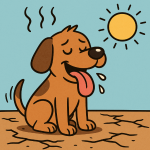
What You Need to Know about Bird Flu and Our Pets:
The world of pet health has faced numerous challenges over the years, but one persistent threat that looms larger today is avian influenza, commonly known as bird flu. This virus, once primarily confined to wild birds and domestic poultry, is increasingly spreading to our beloved pets, reminding us of the interconnectedness of our animal populations.
Understanding Avian Influenza and Its Reach
Bird flu, especially the highly pathogenic avian influenza (H5N1), has significantly broadened its host range. Traditionally affecting birds, this virus is now spreading to other animals, including mammals such as cats and dogs. According to CDC reports, infections in pets often occur after prolonged and unprotected exposure to infected animals, hinting at how intricate and pervasive these transmissions can be.
How Bird Flu Impacts Pets
Pets, particularly cats, are susceptible to severe illness from the H5N1 subtype, often leading to fatal outcomes, as discussed by the American Veterinary Medical Association. This peculiar susceptibility underscores the importance of vigilance among pet owners. Symptoms in pets can include respiratory distress, reduced activity, and fever. The rapid progression from mild symptoms to severe complications requires pet owners to ensure immediate veterinary care if bird flu is suspected.
The Human and Pet Bond in the Age of Avian Influenza
While the primary transmission risk remains between birds, articles from the New York Times suggest minor but noteworthy concerns about cross-species transmission, including to humans. The virus has not yet shown a significant ability to spread widely among people through pet infections, but the potential exists, making it crucial for pet owners to understand and mitigate these risks.
Protecting Our Pets
Preventive measures are critical in safeguarding our pets from bird flu. The GoodRx guide advises that pet owners keep their pets indoors, particularly during outbreaks, and avoid interactions with wild birds. Simple precautions, such as ensuring clean feeding and living environments and minimizing exposure to potentially infected animals, can significantly reduce the risks.
Beyond Individual Precaution: A Community Effort
The threat posed by avian influenza to animal health and welfare is a reminder of the essential role that veterinarians play in disease prevention and control. As discussed in the Journal of the American Veterinary Medical Association, veterinarians are at the forefront of efforts to manage these outbreaks, from monitoring and diagnosis to best practices in treatment and control.
The Broader Implication of Vigilance and Education
At the intersection of pet ownership and public health, avian influenza challenges us to remain informed and proactive. The interconnectedness of our ecosystems means that what affects one species can quickly ripple across to others. By understanding the nuances of bird flu and staying vigilant, we not only protect our pets but also contribute to a larger fabric of community health and safety.
While avian influenza presents a real threat to pet health, thorough knowledge, proper precautions, and community efforts can help mitigate this risk, ensuring that our furry companions remain healthy and safe.




